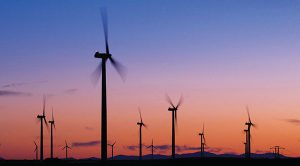Bloomberg
The head of one of the world’s biggest developers of renewable energy, Denmark’s Orsted A/S, worries that the energy transition could see a slowdown as rising competition and interest rates squeeze returns and upend the case for investment.
Orsted is the world’s largest developer of offshore wind farms, which it helped pioneer from a niche technology into one of the fastest-growing forms of renewable energy. Offshore projects can use much larger turbines and are able to tap into stronger and more consistent winds off the coasts. Europe, China, and the US plan to rapidly increase their offshore wind fleets to reach their climate goals.
But while governments all over the world are raising their ambitions to replace fossil fuels with clean electricity, the companies expected to deliver that shift are under financial pressure. Executives are starting to sound the alarm: Growing the industry enough to avoid catastrophic climate change will require trillions of dollars of additional investment, and the ability for wind-power companies to make healthy returns. At the moment, that path to viability is complicated by the rising cost of borrowing money to build clean power plants, plus increased competition; in the future, it could be further complicated
by European windfall taxes on
renewable power producers.
There isn’t much margin to absorb higher costs. A typical offshore wind farm generates a return of about 1% above the cost of capital, Nipper said. A really good project might get up to 3%. Higher interest rates are now eating into that return, and if the price of electricity from the wind farms doesn’t go up, companies won’t be able to invest at the pace needed to achieve climate goals.
Orsted and its green-power competitors have traditionally put pressure on their suppliers to bring down costs. But that’s no longer sustainable: Wind turbine suppliers have lost hundreds of millions of dollars in recent years as they bore the brunt of surging prices for steel and costly supply chain disruptions. Now they’re raising prices.
Despite rising costs, wind power is still a bargain compared to fossil fuels: In Britain, the levelised cost of energy from offshore wind was roughly half that of a natural gas plant in the second half of 2022.
, according to data from clean energy researcher BloombergNEF. Turbines placed on land are even cheaper, and those calculations don’t include the broader benefits of reducing planet-warming emissions.
Creating the impression that wind power costs could only tumble was the biggest mistake that the industry ever made, Henrik Andersen, CEO of the world’s largest turbine maker, Vestas Wind Systems A/S, told Bloomberg last year. Many developers who bought into that promise are now struggling to adjust. In the US, companies meant to be building the first wave of wind farms in the Atlantic Ocean are trying to renegotiate contracts because the price at which they agreed to sell power is no longer viable. There’s a risk that the same could happen in the UK, the world leader for offshore wind following a government auction last year that set a new record low for power price.
To keep up the pace needed to limit climate change, wind power producers are making the case that — even if the price does go up — their product is still cheap. “The price will have to be more realistic,†Nipper said, “which will still be significantly cheaper than any of any fossil fuel.â€
 The Gulf Time Newspaper One of the finest business newspapers in the UAE brought to you by our professional writers and editors.
The Gulf Time Newspaper One of the finest business newspapers in the UAE brought to you by our professional writers and editors.
